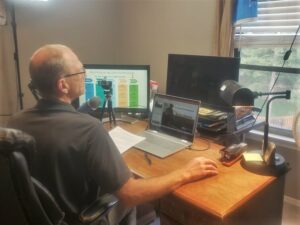How You are disengaging half of your customers!
For them, socializing is actually painful
We start our selling process by the book and with good intentions. We are taught in sales that people buy from people…. Or, people buy from people they like or trust. All very true. So, we think that before we go into a sales presentation, we need to socialize with our customers. Still true in my opinion. This is the part of the sales call where we connect with our customers or prospect on a personal level. We get to know what’s going on with them that day.
However, too often, we go too far. As a sales coach, I get to see firsthand how far is too far. Often, the socializing part of the sales call is the sales call. We get to the farm and we start in on some relevant personal connection discussion. Then we move onto weather, politics or macro-economics of farming. You’ve heard me preach on this before. Quit wasting valuable time talking about aspects you can’t control unless it is specific to this customer’s business decisions. For example, selecting the correct seed based on expected weather patterns is great. Talking about how bad the flooding is on other farms is a waste of time.
As sales professionals, you need to be aware of how much time you spend on this portion of the sales call. Here’s why. As DISC training has taught us, there are four types of people in this world. Hence, the D, I, S, C designation. If not familiar with DISC, you need to be. It’s one of the most important aspects of understanding people when selling (or just communicating with anyone in your life). Contact me if you want to learn more about DISC.
In theory, a quarter of the population is in each quadrant, which means half the people or half of your customers are in the D and C quadrants. In big-picture terms, these are the people that crave control and accuracy. They are also the people who typically don’t like socializing as much as those in the I or S quadrants. So, for half your customers and prospects (D or C profiles), they are actually not comfortable during the socializing phase of the sales call. Those in the D quadrant are dying for you to get to the point so they can make a decision and move on with their day. For them, the socializing phase of the sales call can actually appear to be a fake attempt to sell based on relationship instead of substance. Those in the C quadrant are dying to figure out if what you say is accurate and can be proven based on their understanding of the facts. The socializing phase can actually be painful for this group. They tend to be more introverted and feel uncomfortable when socializing goes too long.
What about the other half of the world? Those customers in the S and I profile are certainly more prone to socializing and see it as a positive – to a point. This group actually wants you to connect as much as you sell. However, we can get carried away with this group and forget why we are on the farm in the first place. Those in the S quadrant will allow you to keep talking and talking – feeling it’s rude to cut you off. Those in the I quadrant will take the conversation over and continue the socializing well beyond what we feel is comfortable. Beware that even this half of your customer base is busy. While they appear to enjoy the socializing, they also have a lot on their plate and may look to you to rein them in and get to the point of your farm call.
What to do:
- Be aware of how much time you are spending on this phase of the sales call. In a 30-minute farm visit, did you spend 27 minutes on the latest gossip about the school board voting and then hand your customer the latest promotion flyer on your sale items, asking them to “take a look at this and let me know if you’re interested?”
- Be aware of your DISC profile and your customer’s DISC profile. The problems begin when we aren’t aware of how our customer wants to be communicated with. We think everyone in the world is just like us. For example, the C salesperson brings in a pile of data and statistics because “that’s what every customer wants – piles of proof in data”. Never stopping to think that customers want you to communicate in their quadrant.
- Learn, rehearse and practice how to transition from socializing to the next phase of the selling process. If you don’t, you will get stuck in the Friend Zone. Making friends with your customers but not selling them anything.
- Special note for the long-term salesperson: If you’ve been calling on a customer for years, maybe decades, I do realize that much of your monthly sales call is a social visit. You know almost everything there is to know about this customer, their family, their farm, and their business. Please keep in mind that you still have a job to do with this customer. You still have to make sure to understand their changing business needs as it relates to your products. Try as hard as you can to not take this account for granted by failing to ask questions and bring them the latest your company has to offer.
I think this can be one of the toughest skills for us to master for any salesperson. I fall into the trap as much as anyone else does. Being more on the D and C side of the scale, I can come across as too direct and cut short the social aspect of the relationship. However, when socializing is working well, I feel great about my relationship with the customer. The customer is openly talking and offering input and the banter is lively. Then, as the conversation turns to the selling process, all of a sudden, it grinds to a halt.
Many of us don’t know how to transition from the socializing phase to the rest of the selling phase. So, we just continue to socialize. Hoping our customer will ask us about why we are on their farm. Plan and practice the transition.
Take a few minutes today and really analyze your sales calls. Roughly time them out. The socializing aspect versus the rest of the selling process. Then make your own determination on whether you spent the right amount of time on it with each individual customer’s desires.




